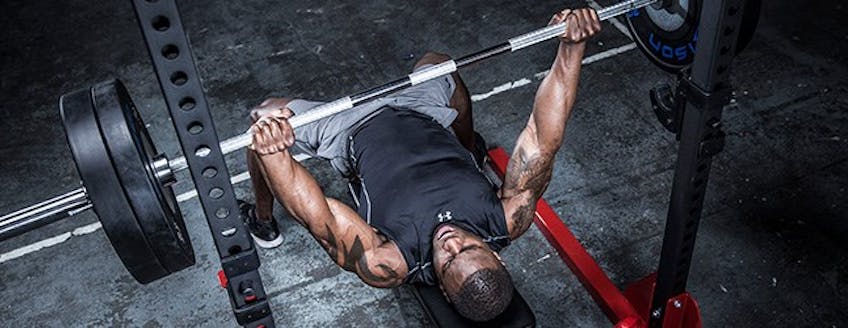Bench Press Training
In the world of bodybuilders, perhaps no other exercise is as revered as the bench press.
If you didn't know this before you went to a gym, you would certainly know it after a few visits, with nearly everyone there lying under the bar at some point.
The bench press is popular for a reason. It develops upper body strength, power and massive amounts of muscle on your chest and triceps. However, you need to get it right. Follow our bench press tips to maximise your workout.
1. Philosophy
Although it is an upper body exercise, don't let your legs dangle aimlessly off the end of the bench, as this is as much use as a bike to a fish.
You’ll need to learn how to ‘turn on’ your hips and legs and realise that the bench press requires the entire body to work in harmony. If you plant your legs correctly when you bench, you can increase the stability in your core and shoulders. You need to actively drive your legs down into the floor as your arms and chest take the weight of the bar. This will be key when it comes to breaking through plateaus.
The theory is, the tighter you get in your legs and lower body, the more control you’ll have over the lift and the weight. If you can coordinate all of these muscle groups during the bench press you can make major gains, both in terms of strength and size.
After you have your legs sorted, it is time to look at your hands. The grip is key to creating the correct tension and allowing fluidity in the movement. Creating tension in the upper body starts with your grip on the bar. You really need to see those knuckles whiten just before the lift. The harder your grip, the tighter the chest will be - in the bodybuilder lexicon it is known as ‘irradiation’.
Remember when we said that your whole body needs to work in harmony? Here's the true test. When you take the bar off the rack, instead of relaxing and dropping the bar down to your chest, engage your lats and actively pull the weight down in a similar motion to a seated cable row.
This doesn't mean you use gravity and your back to hurtle a 80kg weight directly towards your chest, but rather control the movement. If done correctly it automatically drives your chest upward and limits the extension of your shoulder at the bottom of the lift.
2. Technique
No good bench press tips could ignore the technical side of the lift. To begin, lie on the bench under the bar with your legs comfortable, around shoulder distance apart.
Take a tight grip on the bar at an equal distance on each side of the knurling. Often this is around shoulder width apart. Focus on the tension from your hands, forearms, upper arms, shoulders, back and chest.
Gulp in some air and replicate the pushing movement with the bar still racked. Drive your chest upwards, pulling your shoulder blades back and down into the bench.
Unrack the weight. Always use a spotter if you are getting towards your limit. As you move the bar directly over your chest, you need to ensure that the tension is not lost from your upper back and your chest allowed to collapse.
Take another deep breath and lower the weight, engaging your lats until the bar is slightly off your chest. Make sure that your elbows have stayed in alignment with your wrists.
Keep the tension in your chest and push the bar back up to its starting position. Engage your legs. Plant your feet and drive them into the floor, squeezing your glutes to lock your hips into place. Exhale.
Take a new breath and repeat for the next repetition. Next why not try changing the angle?

















